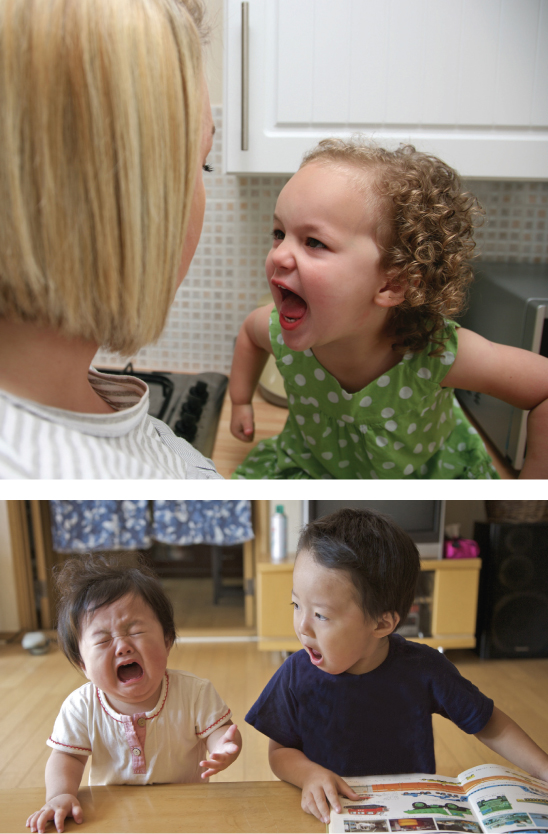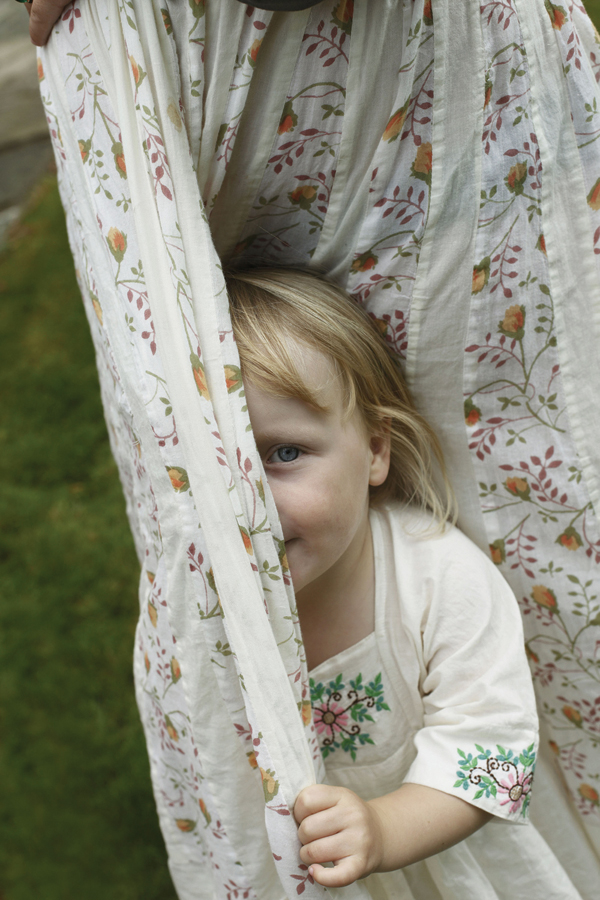6.1 Emotional Development
Children gradually become more capable in every aspect of their lives, including learning when and how to express emotions (Buckley & Saarni, 2009; Denham et al., 2003; Morrison et al., 2010). Controlling the expression of emotions, called emotional regulation, is the pre-
Such regulation is very difficult in infancy, but when the emotional hot spots of the limbic system connect to the maturing prefrontal cortex, children become more aware of their reactions and better able to control them. Emotional regulation is a lifelong necessity and no one does it perfectly all the time.
Initiative Versus Guilt
During Erikson’s third developmental stage, initiative versus guilt, children acquire many skills and competencies. Initiative can mean several things, such as saying something new, extending an ability, or beginning a project. Depending on the outcome (especially reactions from other people), children feel proud or guilty.
Usually, North American parents encourage enthusiasm, effort, and pride in their 3-
ESPECIALLY FOR Teachers One of your students tells you about playing, sleeping, and talking with an imaginary friend. Does this mean that the child is emotionally disturbed? 
No, unless the student is over age 10. In fact, imaginary friends are quite common, especially among creative children. The child may be somewhat lonely, though; you could help him or her find a friend. 
Protective OptimismChildren’s beliefs about their worth are connected to parental confirmation, especially when parents remind their children of their positive accomplishments (“You helped Daddy sweep the sidewalk? You made it very clean.”) (Reese et al., 2007). Remember that Erikson described autonomy at age 2, often expressed as stubbornness, and nicknamed the terrible twos. By age 3, autonomy is better regulated, soon becoming initiative, as children are eager to learn new skills (Rubin et al., 2009).
Over the next several months, children develop a self-concept, which is the cognitive ability to understand that they are separate from others. For example, young children are given choices: “Water or juice?” “Blue pyjamas or red ones?” The act of choosing makes children believe they are independent agents (Kim & Chu, 2011). In North America, self-

Erikson recognized that young children are not accurate in their assessment of themselves. They believe that they are strong, smart, and good-
At this age, a positivity bias encourages children to try unfamiliar activities, make friends, begin school, and so on (Boseovski, 2010). They learn to pour juice, zip pants, or climb trees, undeterred by overflowing glasses, stuck zippers, or a perch too high. Faith in themselves helps them persist.
Brain MaturationThe new initiative that Erikson describes benefits from myelination of the limbic system, growth of the prefrontal cortex, and a longer attention span, all made possible by the neurological maturation described in Chapter 5. Emotional and cognitive maturation develop together, each enabling the other to advance (Bell & Calkins, 2012).
Normally, neurological advances in the prefrontal cortex at about age 4 or 5 make children less likely to throw a temper tantrum, engage in a physical attack, or burst into giggles (Kagan & Herschkowitz, 2005). Throughout early childhood, behaviours such as violent outbursts, uncontrolled crying, and terrifying phobias (irrational, crippling fears) diminish. The capacity for self-
213

In one study, researchers asked children to wait 8 minutes while their mothers did some paperwork before opening a wrapped present that was in front of them (Cole et al., 2011). The children used strategies such as distractions and private speech. Keisha was one of the study participants:
“Are you done, Mom?”…“I wonder what’s in it”… “Can I open it now?” Each time her mother reminds Keisha to wait, eventually adding, “If you keep interrupting me, I can’t finish and if I don’t finish …” Keisha plops in her chair, frustrated. “I really want it,” she laments, aloud but to herself. “I want to talk to Mommy so I won’t open it. If I talk, Mommy won’t finish. If she doesn’t finish, I can’t have it.” She sighs deeply, folds her arms, and scans the room… the research assistant returns. Keisha looks at her mother with excited anticipation. Her mother says, “OK, now.” Keisha tears open the gift.
[Cole et al., 2011]
Motivation
Motivation (the impulse that propels someone to act) comes either from a person’s own desires or from the social context. Intrinsic motivation occurs when people do something for the joy of doing it: A musician might enjoy making music, even when no one else hears. Thinking back to your own childhood, did you have a hobby you loved, one that your parents didn’t have to force you to pursue? That’s another example of intrinsic motivation. Extrinsic motivation comes from outside the person, when people do something to gain praise (or some other reinforcement), such as a musician playing for applause or money.
Encouraging intrinsic motivation is crucial in teaching young children (Cheng & Yeh, 2009). Preschool children are often intrinsically motivated. They wake up eager to start playing and practising, whether or not someone else wants them to. Praise and prizes might be appreciated, but that’s not why children work at what they do. When playing a game, they might not keep score; the fun is in the activity (intrinsic), not the winning.
It is only when others impose an external reward, for example by making the game competitive with prizes and trophies to be won, that children who were initially intrinsically motivated become extrinsically motivated. With extrinsic motivation, children often lose their pure love for the game. Personal joy and interest are soon replaced by a desire for the rewards.
An Experiment in MotivationIn a classic experiment, preschool children were given markers and paper and assigned to one of three groups that received, respectively: (1) no award, (2) an expected award (they were told before they had drawn anything that they would get a certificate), and (3) an unexpected award (after they had drawn something, they were told, “You were a big help,” and got a certificate) (Lepper et al., 1973).
ESPECIALLY FOR College and University Students Is extrinsic or intrinsic motivation more influential in your study efforts? 
Each is important. Extrinsic motivation includes parental pressure and the need to get a good job after graduation. Intrinsic motivation includes the joy of learning. Have you ever taken a course that was not required and was said to be difficult? That was intrinsic motivation. 
214
Later, observers noted how often children in each group chose to draw when they were no longer part of a group. Those who received the expected award were less likely to draw than those who were unexpectedly rewarded. The interpretation was that extrinsic motivation (condition 2) undercut intrinsic motivation.
This research triggered a flood of studies seeking to understand whether, when, and how positive reinforcement should be given. The consensus is that praising or paying a person after an accomplishment sometimes encourages that behaviour. However, if payment is promised in advance, that extrinsic reinforcement may backfire (Cameron & Pierce, 2002; Deci et al., 1999; Gottfried et al., 2009).
Praise is effective if connected to the particular production, not to a general trait (“you did a good drawing,” not “you are a great artist”), because then the child believes that effort paid off, which motivates a repeat performance (Zentall & Morris, 2010).
Culture and Emotional Control

KOICHI SAITO/AMANAIMA/AGE FOTOSTOCK
Although there is considerable variation within, as well as among, cultures, national emphases on regulating emotions seem to include the following (Chen, 2011; Harkness et al., 2011; Miller, 2004; Stubben, 2001):
- fear (United States)
- anger (Puerto Rico)
- pride (China)
- selfishness (Japan)
- impatience (many Native American communities)
- disobedience (Mexico)
- erratic moods (the Netherlands).
Control strategies vary as well (Matsumoto, 2004). Peers, parents, and strangers sometimes ignore emotional outbursts, sometimes deflect them, sometimes punish them, and so forth. Shame is used when social reputation is a priority. Indeed, in some cultures, “pride goeth before a fall” and people who “have no shame” are considered mentally ill (Stein, 2006).
Cultural differences are also apparent in emotional expression: Children may be encouraged to laugh, cry, and yell, or to hide their emotions (Kim et al., 2008). Some adults guffaw, slap their knees, and stomp their feet for joy; others cover their mouths with their hands if a smile spontaneously appears. Children learn to do the same.
Finally, temperaments vary, which makes people within the same culture unlike one another: “Cultures are inevitably more complicated than the framework that is supposed to explain them” (Harkness et al., 2011). Nonetheless, parents everywhere teach emotional regulation as their context expects. Unfortunately, children of parents who suffer from mental illness such as depression, bipolar disorder, or schizophrenia are less able to regulate their emotions (Kovacs et al., 2008).
215
A VIEW FROM SCIENCE
Sex Differences in Emotional Regulation
Biologically, the differences between males and females are minor, at least until puberty. Only one gene (SRY) on one of the 46 chromosomes (the Y) causes the difference in genitals. Most aspects of physical and cognitive growth are the same for all children. When differences appear, they are in averages, not absolutes. For example, girls average slightly more body fat than boys, but many boys weigh more than the average girl.
This overlapping of characteristics is one of two crucial points that scientists stress when they consider sex differences. Beyond anatomy, it is never true that all the boys have one trait and none of the girls do, or vice versa. The sexes overlap; they are not opposites.
The second crucial point is that both nature and nurture are connected to every difference that is found between boys and girls. For instance, even the fact that girls have more body fat than boys may seem to be nature, but among poor families in India, girls have less fat than boys, on average. The reason is cultural: When food is scarce, boys are better fed.
Now to emotional regulation. On average, young girls are advanced in controlling their emotions, particularly anger, compared with boys. One study traced externalizing and internalizing emotions from early to middle childhood. Researchers gave 5-

Many boys showed Mark and Scott hitting and kicking. Boys whose externalizing behaviour worsened between ages 5 and 9 (as rated by teachers and parents) were the most likely to dramatize such attacks at age 5. By contrast, 5-
The authors of the study wrote:
Gender-
[Zahn-
These researchers suggest that extreme externalization or extreme internalization predict future psychopathology. Because of gender differences, mistreated boys are likely to externalize and mistreated girls to internalize. By age 5, without emotional regulation, maltreated boys throw and hit, and maltreated girls sob uncontrollably or hide.
Later you will read that men are more likely to become antisocial or schizophrenic, while women are more likely to be overwhelmed by anxiety or depression. Perhaps as a result, females have more suicide attempts, but males more often kill themselves—
In the study of 5-
216
Seeking Emotional Balance
At every age, in all cultures, caregivers try to prevent psychopathology, an illness or disorder (-pathology) of the mind (psycho-). Although symptoms and diagnoses are influenced by culture—
Externalizing and Internalizing ProblemsWithout adequate regulation, emotions can be overwhelming. Intense reactions occur in two opposite ways, as you might expect from the activate–
Some people have externalizing problems: Their powerful feelings burst out uncontrollably. They externalize rage, for example, by lashing out or breaking things. Without emotional regulation, an angry child might flail at another person or lie down screaming and kicking. By age 5, children usually have learned more self-
Other people have internalizing problems: They are fearful and withdrawn, turning distress inward. Emotions may be internalized via headaches or stomach aches. Although the cause is psychological, the ache is real.
Again, with maturity, the extreme fears of some 2-
KEY Points
- Emotional regulation is the crucial psychosocial task in early childhood.
- Erikson thought young children are naturally motivated to take initiative, with joy at new tasks, yet vulnerable to feeling guilty.
- Brain maturation and family guidance help children regulate their emotions, avoiding either extreme externalizing or internalizing reactions in a culturally appropriate way.
- Young girls are less aggressive and more advanced in controlling their emotions, but virtually all sex differences are in averages, not absolutes.
- Controlling emotions is influenced by both genetics and culture. Difficulties in controlling emotions can lead to externalizing and internalizing problems.